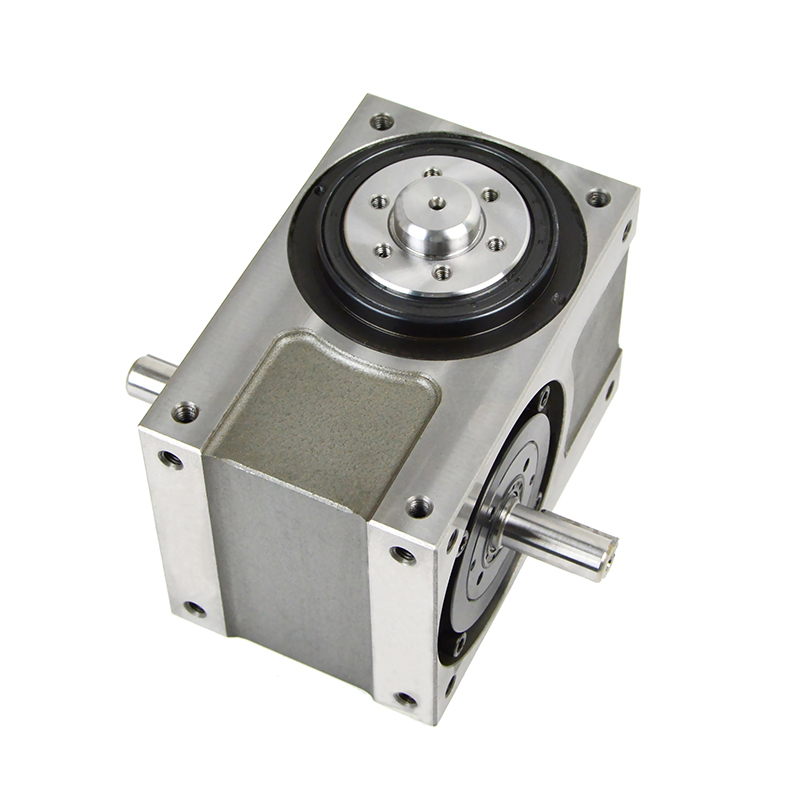The lubrication method of the cam indexing device needs to be comprehensively selected based on the working conditions (speed, load, ambient temperature, etc.), installation form, and maintenance cost. It is mainly divided into two types: grease lubrication and oil lubrication:
grease
Applicable scenarios: low-speed (≤ 150r/min), light load, vertical installation or inconvenient maintenance scenarios (such as food machinery, packaging equipment).
Advantages: No need for complex fuel supply system, low sealing requirements, long maintenance cycle (usually replaced every 1-2 years).
Limitations: Poor heat dissipation ability, prone to failure at high temperatures or speeds, requiring the use of high-temperature grease (such as synthetic alkyl grease).
oil
Applicable scenarios: High speed (>150r/min), heavy-duty or precision indexing equipment (such as electronic component assembly lines).
Advantages: High heat dissipation efficiency, capable of removing wear particles and extending lifespan; Continuous lubrication can be achieved through a circulatory system.
Limitations: It requires the configuration of an oil pump, oil tank, and sealing structure, which is costly and requires regular monitoring of oil level and cleanliness.

Special environment adaptation
Cleanroom: Use food grade grease (such as NSF H1 certification) to avoid contamination.
High temperature environment: using silicone oil or perfluoropolyether (PFPE) grease, with a temperature resistance of over 200 ℃. Low temperature environment: Use low viscosity lubricating oil (such as ISO VG 32) or cold resistant grease (such as polyurea based grease). 2、 Analysis of the Effects of Lubrication Failure
Lubrication failure is the main cause of cam splitter failure, and its hazards include: increased mechanical wear and direct contact between the cam and roller surfaces, leading to metal fatigue peeling (pitting), and decreased indexing accuracy (such as positioning deviation>± 30 arc seconds).
Case: A printing machine experienced roller wear of 0.1mm within 3 months due to dry grease, resulting in overprinting errors. Abnormal temperature rise and frictional heat generation cause the internal temperature to exceed 80 ℃, leading to material softening (such as tempering of the quenched layer on the cam surface) and a decrease in hardness of 5-10 HRC.
Actual test data: A high-speed cam splitter ran for 10 minutes in a state of oil shortage, and the surface temperature suddenly rose to 120 ℃. The damage of vibration and noise lubrication film leads to an increase in impact load, and the peak vibration acceleration can reach 3-5 times that of normal working conditions, with a noise level exceeding 85dB.
In extreme cases of functional failure risk, the roller may get stuck or the cam may break, causing the equipment to shut down. A certain automobile production line suffered losses of approximately 150000 yuan per hour due to such malfunctions.
3、 Preventive measures and maintenance strategies: Optimization and selection of lubrication schemes: According to the manufacturer's manual recommendations for lubrication grades (such as Shell Alvania R2, Mobil SHC 629), avoid mixing different base greases. Oil injection control: The grease lubrication filling amount is 1/3-1/2 of the chamber volume, and excessive filling can easily cause stirring and heating. Sealing and pollution protection adopt double lip sealing (such as nitrile rubber+fluororubber composite sealing) to prevent dust and moisture from entering. Regularly clean the ventilation holes to avoid lubricant leakage caused by pressure imbalance. Condition monitoring and predictive maintenance temperature monitoring: Install thermocouples on the outer wall of the cam chamber and set warning thresholds (such as>70 ℃). Oil analysis: The iron content (normal<20ppm) is detected by a spectrometer. If it exceeds 50ppm, the oil should be changed immediately. Vibration detection: Use acceleration sensors to collect frequency signals and identify abnormal contact frequencies between rollers and cams (such as high-frequency components of 10-20kHz). Establish an emergency response plan for lubrication failure in the emergency handling process: Level 1 alarm: abnormal temperature → stop the machine to check the seal and oil level. Level 2 alarm: Excessive vibration → Disassemble and inspect for wear status. Level 3 alarm: sudden abnormal noise → stop the machine immediately and return to the factory for maintenance. 4、 Typical case and improvement plan: A pharmaceutical machinery cam splitter frequently fails. After analysis, it was found that the root cause of the problem is the loss of ordinary lithium based grease in a 40 ℃ environment, leading to cam wear. Improvement measures: Replace with high-temperature composite calcium sulfonate based grease (drip point>250 ℃). Add a labyrinth sealing structure to reduce dust intrusion. Install a temperature sensor linked shutdown system. Effect: The maintenance cycle has been extended from 3 months to 1 year, and the failure rate has decreased by 90%. 5、 The lubrication system of the cam splitter is the key to ensuring its accuracy and lifespan. Through scientific selection, sealing optimization, and intelligent monitoring, lubrication failure can be effectively prevented and the risk of equipment shutdown can be reduced. The future trend will develop towards full lifecycle management (LCM), combined with IoT technology to achieve real-time perception and decision support of lubrication status.
 Cheng Shen Precision Machinery (Shanghai) Co., Ltd.
Cheng Shen Precision Machinery (Shanghai) Co., Ltd.